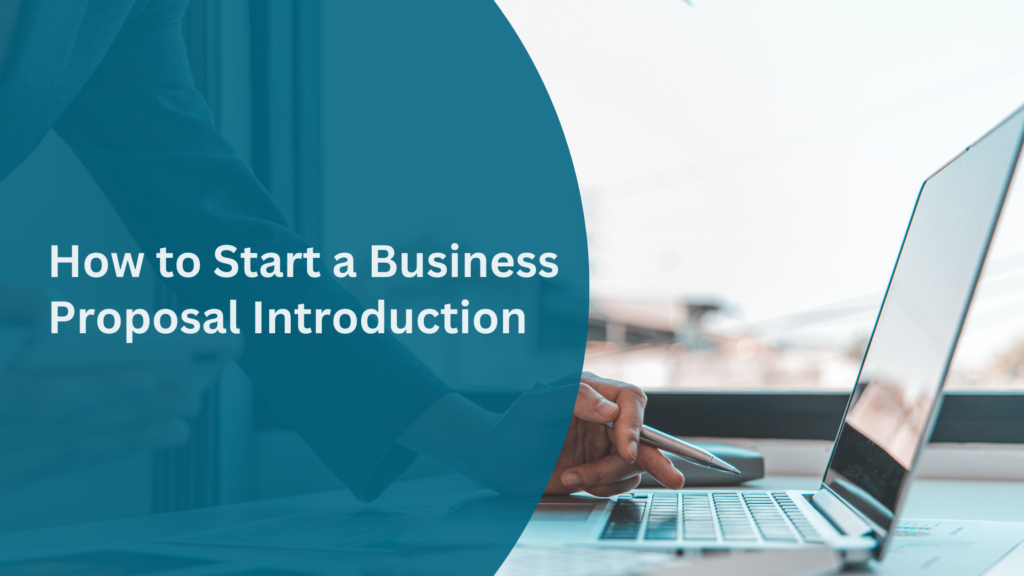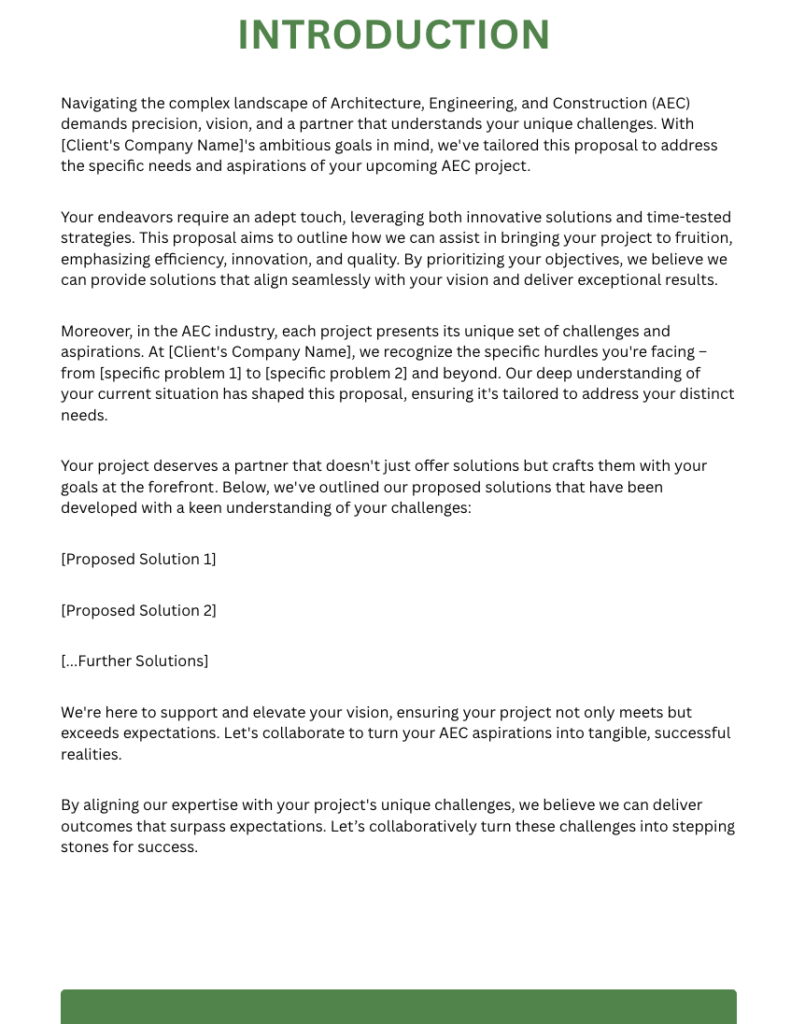How to Start a Business Proposal Introduction + Free Template

In the business world, making a great first impression can make all the difference in landing a client. And when it comes to proposals, the first impression starts with the introduction.
But, how do you write an introduction that captivates from the get-go? In this blog, we unravel the art of writing a compelling business proposal introduction, and we also include a free template to set you on the path to success.
Learn the essential tips to grabbing the client’s attention to help you feel confident about your proposal writing process. Are you ready to win more clients? Let’s begin!
What Is the Introduction of a Business Proposal?
The introduction of a business proposal offers a broad overview showing you understand the objectives and goals of the client. As the initial point of reference for readers to grasp your solution, it’s important to invest time and care into crafting the introduction. An impactful and captivating business proposal introduction sets a clear picture of the objectives and the strategies you intend to use.
To create a winning proposal, the proposal introduction should captivate the reader and offer a concise overview without too many specifics. It sets the stage for the main content of your business proposal by highlighting the main themes and introducing the focus points that will be discussed.
The introduction to your business plan is not the same as the executive summary. The executive summary provides more detail and specifics. The business proposal introduction comes right after the executive summary and it helps create the tone for your proposal.
The summary provided in the introduction serves as a guide for what to include when writing each section of your business proposal. After completing the proposal, check the introduction to confirm that all essential points have been properly addressed.
What Is the Difference Between an Executive Summary and a Proposal Cover Letter?
If you’ve been requested by a potential client to submit a proposal or you’re responding to an official RFP, you’re probably familiar with both cover letters and executive summaries. However, which one should you include in your proposal? And how do they differ?
Both an executive summary and a proposal cover letter are integral parts of a business or project proposal, but they serve different purposes and have unique content structures. Although there are several similarities between these two parts of a proposal, cover letters, and executive summaries have distinct differences, especially when it comes to when and how they are used.
Both the cover letter and the executive summary are placed at the start of your proposal, and each should be brief and straight to the point. However, a proposal cover letter offers a brief introduction to a project, whereas an executive summary provides a more comprehensive overview of proposal reports and materials.
Here’s a brief overview of how cover letters and executive summaries differ from each other:
Cover Letters
- The first written section of the proposal
- Make the first impression
- Focus more on the personal relationship with the client
- Connect with buyers on a more human level
- The perfect place to show you truly understand the client’s challenges and how your firm will help
- On company letterhead
- Signed by a high-ranking member of the team/company
- Placed directly after the proposal cover page and before the table of contents (unless instructed otherwise in the RFP)
- 3–5 paragraphs
- 1 page
The goal is to make the cover letter feel personal and catch the reader’s attention, so they are more likely to read the entire proposal.
Executive Summaries
- A summary of the entire proposal
- Focused on the details of the project and less on your relationship (or possible relationship) with the client
- Starts with a summary of the client’s challenge
- Details a quick overview of the solution proposed
- Highlights the unique components you’re offering
- Placed right after the table of contents and before the rest of your proposal.
- The executive summary is optional, and not a requirement of an RFP
- If your proposal is less than 20 pages, you probably won’t need one
- 5 paragraphs
- 1–2 pages
When compared to cover letters, executive summaries often include more data and serve as condensed versions of a proposal, allowing readers to quickly familiarize themselves with extensive content without reading the entire document.
How Do You Start an Introduction for a Proposal?
Starting the writing of your introduction for a proposal can sometimes feel like the most difficult step. When staring at a blank page, you may experience “blank page syndrome” or “writer’s block.” This makes writing seem impossible to overcome.
Finding the right idea, the first few words, and completing the first sentence seem like a difficult task. Whether you’re writing a book or a proposal, finding the first few words can often be challenging.
However, doing research and creating an outline can help you craft a compelling introduction that sets the tone for your proposal. Here’s how:
Do Your Research
To help you get started, make sure to do your research on the project and the client. You should understand the problem or opportunity you’re addressing. Research the specific needs of the client to make the proposal more personalized.
Dedicating time to understanding a client’s needs shows your commitment to going above and beyond for their project. This effort will also allow you to create a more customized plan, streamlining the process when it’s time to execute it.
Create an Outline
Next, organize your thoughts by creating an outline. Going back to writer’s block, one of the main reasons writers experience blocks is because they are unsure of what to write next. An outline provides a clear path, helping reduce the chances of getting stuck.
Moreover, this doesn’t just pertain to the entire proposal, but also to the introduction itself. Make sure to highlight any elements you think are essential to include in your introduction. The purpose of an outline is to establish a framework for the business proposal. This not only facilitates a smoother writing experience but also helps in structuring the content for the introduction.
Simply put, an outline helps in ensuring you don’t miss out on any crucial point and provides a structure to flow with.
Business Proposal Introduction Tips
To start with a strong proposal introduction, here are some foolproof tips:
Keep It Short
The business proposal introduction aims to capture the reader’s attention and present a concise overview. Therefore, begin by creating the introduction to your proposal, offering a brief overview of all the sections within the business plan. Your business proposal introduction should provide an overview of the proposal as a whole while keeping it brief and straight to the point.
By highlighting the central themes, it sets the stage for the main content, letting the reader know what will be discussed in the next sections of your proposal.
Address the Problem
Because it’s the introduction, you don’t have to mention every detail, but it’s best if you at least provide a summary of how you’ll address the problem. You can do this in just a couple of sentences. It’s crucial to offer companies an attainable and realistic solution to avoid getting your proposal pushed to the side. Highlighting this in the introduction will catch their attention, allowing you to explain further in the rest of your proposal.
Focus on the Solution
The introduction should center on the proposed solution and the measures you intend to take to achieve results. After all, the main goal of a business proposal is to offer a solution to the client’s problem.
To do this, an effective method is to identify the problem and then highlight the solution. Focus on the proposed solutions you will address in the complete proposal to demonstrate how you are uniquely qualified and perfectly positioned to address the challenge.
Frame your introduction in the following way to create a flow that helps the reader follow your story and connect with it:
- Problem
- Solution
- Opportunity
Include a Maximum of 3–5 Points
While you may want to pack in all the details in the introduction, the most effective proposal introductions are concise and 1–3 pages. Therefore, you should focus only on the 3-5 key points that will deeply connect with the prospect and highlight those in the introduction. If this proves challenging, come up with larger categories to fit multiple key points under each category.
Put the Prospect First
A great and effective tip to an outstanding business proposal is focusing on the prospect and the value you offer—rather than what they can offer you.
Rather than talking about yourself and your firm, make your business proposal to focus entirely on the prospect. It’s easy to forget this focus when we’re trying to promote our own accomplishments at the same time. However, speaking directly to the potential client in the introduction demonstrates that you’re eager and prepared to work with them.
Remember to Edit Your Introduction for Your Business Proposal
Don’t forget, that the proposal introduction is your first impression. This means you don’t get a re-do, so it should be error-free and well-written with a professional tone. Even with an amazing and compelling proposal, a grammatical error in the introduction can start you off on the wrong foot, causing you to lose the client.
Simply running a brief spelling and grammar check before submitting isn’t enough for a business proposal. You should provide a high-quality proposal free of mistakes. Therefore, while drafting and after ensuring everything is correct, continuously review your document until it meets perfection.
Implement a DAM
A Digital Asset Management (DAM) system, like OpenAsset, can significantly help in the process of creating RFP responses, including proposal introductions in several ways. If you have specific templates for different types of proposals, you can create documents in seconds. A good DAM will store these templates for easy access and application, ensuring consistency and quality across different proposals.
Moreover, a DAM system can streamline the process of creating proposal introductions by ensuring easy access to quality, brand-consistent assets, fostering collaboration, and maintaining efficiency throughout the process.
Example of Introduction in Business Proposal
Now that we know how to create a foolproof business proposal introduction, let’s take a look at what a business proposal introduction sample would look like in the AEC industry.

Free Proposal Introduction Template for Your Proposal Response
Below, you can download a FREE proposal introduction template made for the AEC industry. This will provide a straightforward starting point for your next proposal.
How to Write an Effective Proposal Introduction
Creating quality proposal introductions over and over again isn’t a simple job. However, as the #1 DAM for AEC and Real Estate, OpenAsset can help you find, share, and use the digital assets you need to create high-quality AEC proposals quickly and easily.
With dozens of integrations and useful features, OpenAsset makes it easy to share and manage the heavy amounts of digital assets needed to create winning proposals.
Get your free downloadable proposal introduction template today. And if you’d like to learn more about our DAM technology, you can reach out to one of our digital asset experts today to schedule a demo.
The post How to Start a Business Proposal Introduction + Free Template appeared first on OpenAsset.